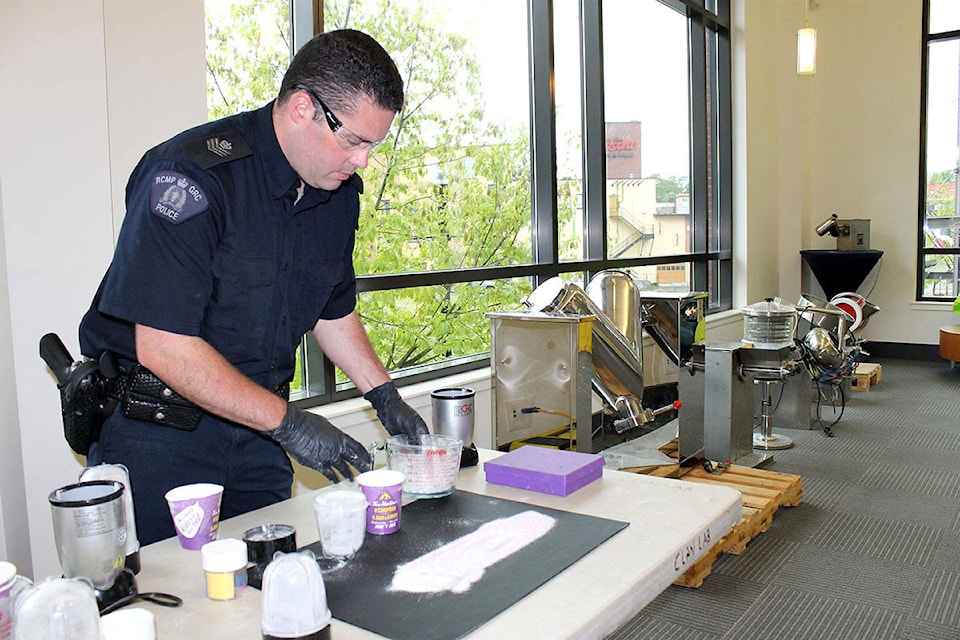Not every cookie has the same number of chocolate chips – and just like the chance of getting more chocolate in one bite, so can people get ‘hot spots’ of deadly fentanyl in the same batch of street drugs.
It’s why two people will share drugs and only one will overdose, or why someone will overdose even when they’ve used the drug before, according to the RCMP and Island Health.
Drug overdoses and deaths have become a public health emergency in B.C. In Nanaimo alone, more people died of illicit drug overdoses in 2016 than any other year in the past decade and 13 people died in the first three months of this year, according to statistics from the B.C. Coroners Service.
This month, law enforcement and public safety investigators met in Nanaimo for a workshop on safeguards against fentanyl, as well as on fentanyl trafficking, investigations and prosecution strategies. There were also pill presses seized by law enforcement on display, which RCMP Sgt. Eric Boechler, with the federal serious organized crime section, used to show media how counterfeit pills are being produced and how there can be ‘hot spots’ or high concentrations of fentanyl in the same batch. As little as two milligrams of fentanyl can be lethal.
According to Boechler, fentanyl is a powerful synthetic opioid drug that traffickers are using to replace heroin or to sell as heroin, and use as an active ingredient in counterfeit oxycontin. He said organized crime ships product where they can make money – a reason why the RCMP is working with partners like municipal police, coroner services and Health Canada to identify new trends, as well as with U.S. agencies. He’s also training with agents in the U.S. because he said it’s the same issue that they’re seeing, “we unfortunately have been hit with it first.”
The industry is also changing.
Staff Sgt. Conor King, with the Victoria City Police Department and co-producer of the workshop, said chemical components manufactured by illicit labs in China are outpacing the ability to regulate them in Canada and the U.S., so there’s concern there are potent drugs that aren’t actually illegal. There’s a lot of effort in the world of chemical analysis labs, such as Health Canada, to quickly determine what analogues of fentanyl are coming in and make sure regulations are in step, he said.
It’s that innovating drug industry that Dr. Paul Hasselback, Island Health’s chief medical officer for Central Vancouver Island, sees as the reason why things aren’t getting better in spite of services being provided.
“Four years ago when it first started here in Nanaimo, it was fentanyl, January of last year it was 3-Methylfentanyl and in November, it was carfentanil hitting the streets,” he said. “Each time one of these have led to a surge; we’ve continued to have a surge in fatalities subsequent to the introduction of one of these fentanyl analogues and that’s the illicit drug industry innovating and marketing at a faster, more rapid rate than we’re able to respond at the moment.”
Hasselback believes there’s a need to adjust the approach by recognizing addiction as a medical disease and provide the health services necessary to someone as with anyone with a chronic illness. There’s an ongoing problem with substances and the incorporation of fentanyl has unmasked an underlying issue of opioid dependency, let alone other drug use, he said.
Fentanyl has become popular with organized crime because it’s cheap to purchase and profitable, according to Sgt. Rob Christenson of the Nanaimo RCMP, who also said heroin users have moved to fentanyl because it’s stronger and produces a more euphoric high. Somewhere along the line dealers and producers have realized they can capitalize on the market and it’s like a ‘craze’ – everybody seemed to get into it whether through addiction or unknowingly it’s hard to tell, he said, but when you’re hooked, that’s what people want.
“Unfortunately it’s here to stay.”
Christenson said the city hasn’t seen W-18 – “another bad one everyone was worried about” – or pure fentanyl, but he also said the day will come where they will see it and they’ll have to deal with it when it gets here. He’s working with other agencies, as part of a three-part approach to reduce deaths in Nanaimo and B.C., with a focus on targeting people trafficking fentanyl.
“It has forced us at times to prioritize the drug investigations and as soon as you put fentanyl on that list it becomes No. 1 automatically,” said Christensen. “As long as it’s here to stay, unfortunately it’s going to be the priority because people are dying.”
news@nanaimobulletin.com
